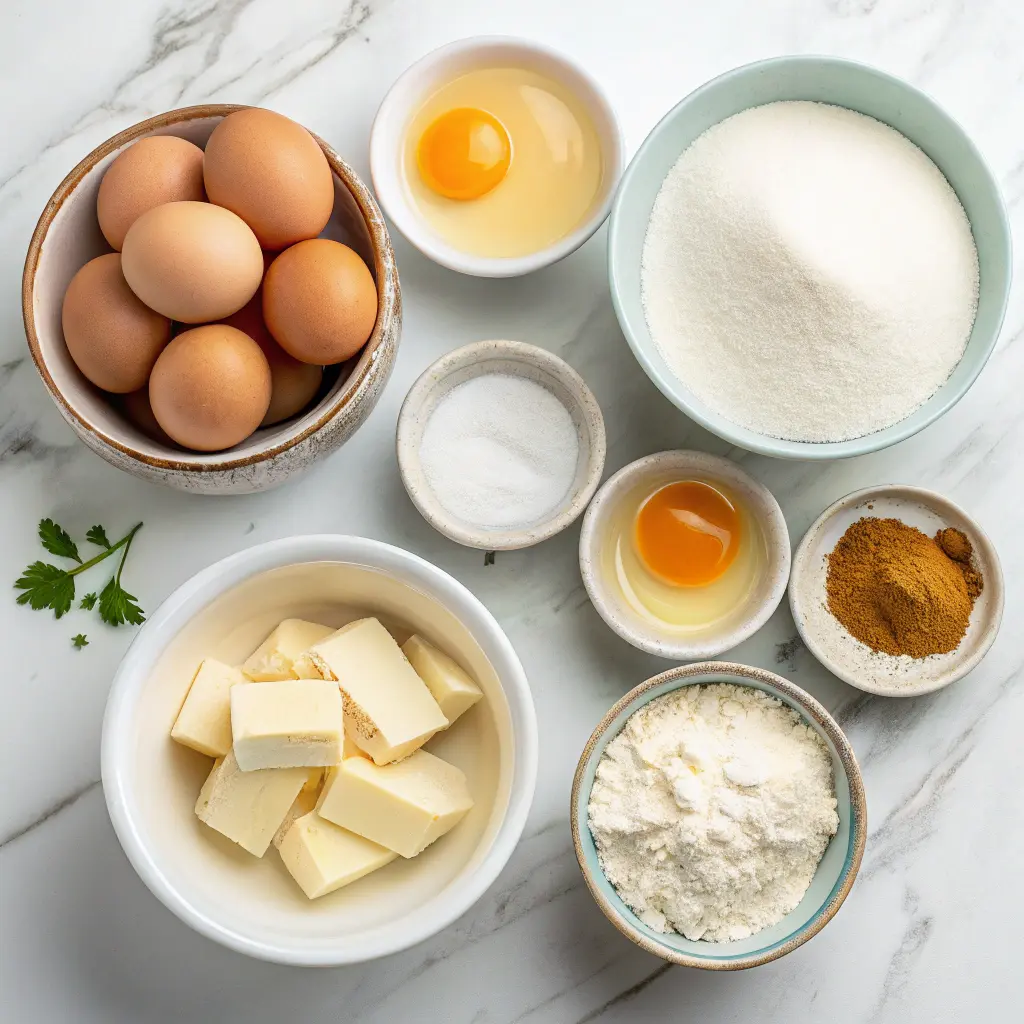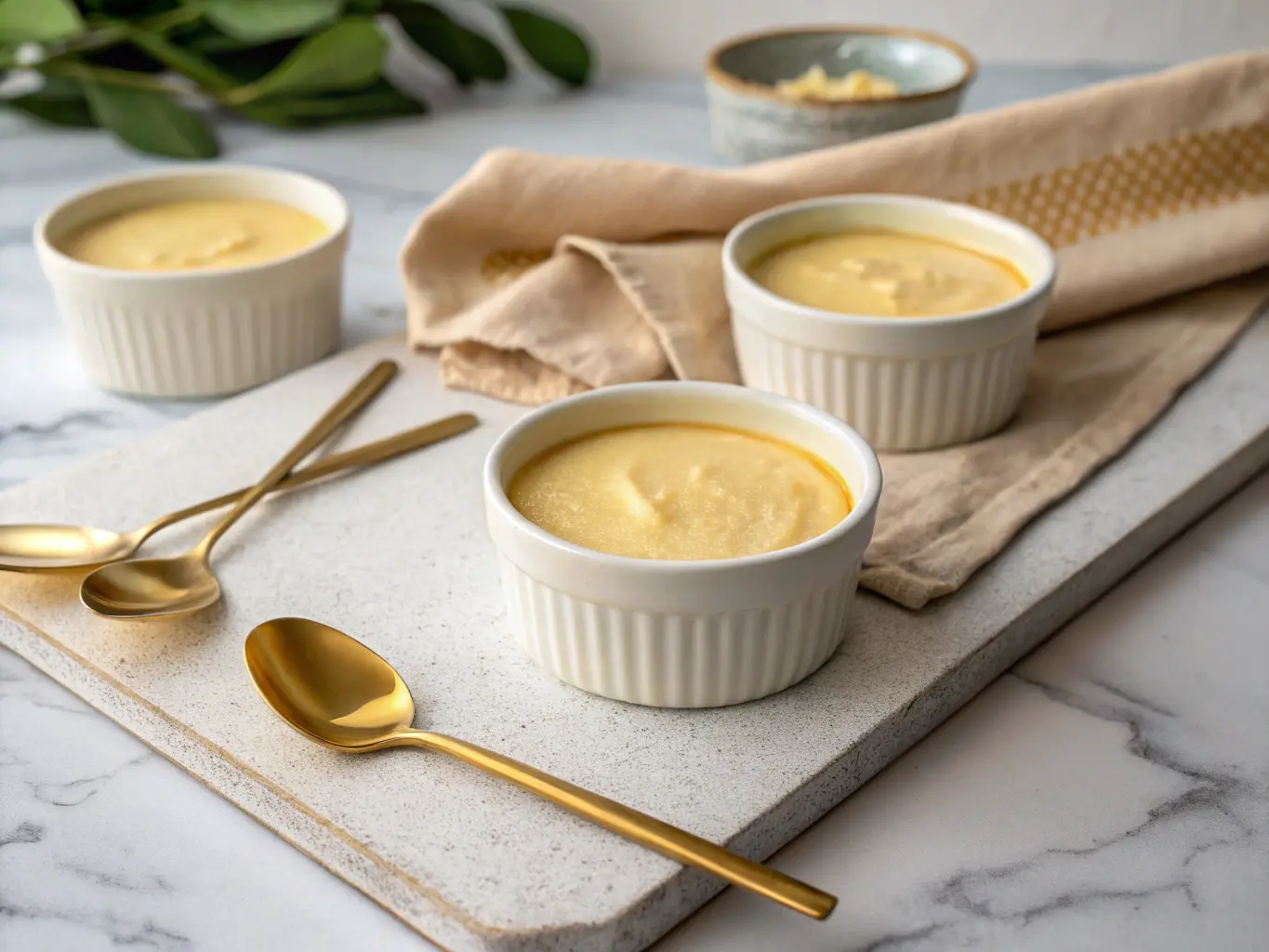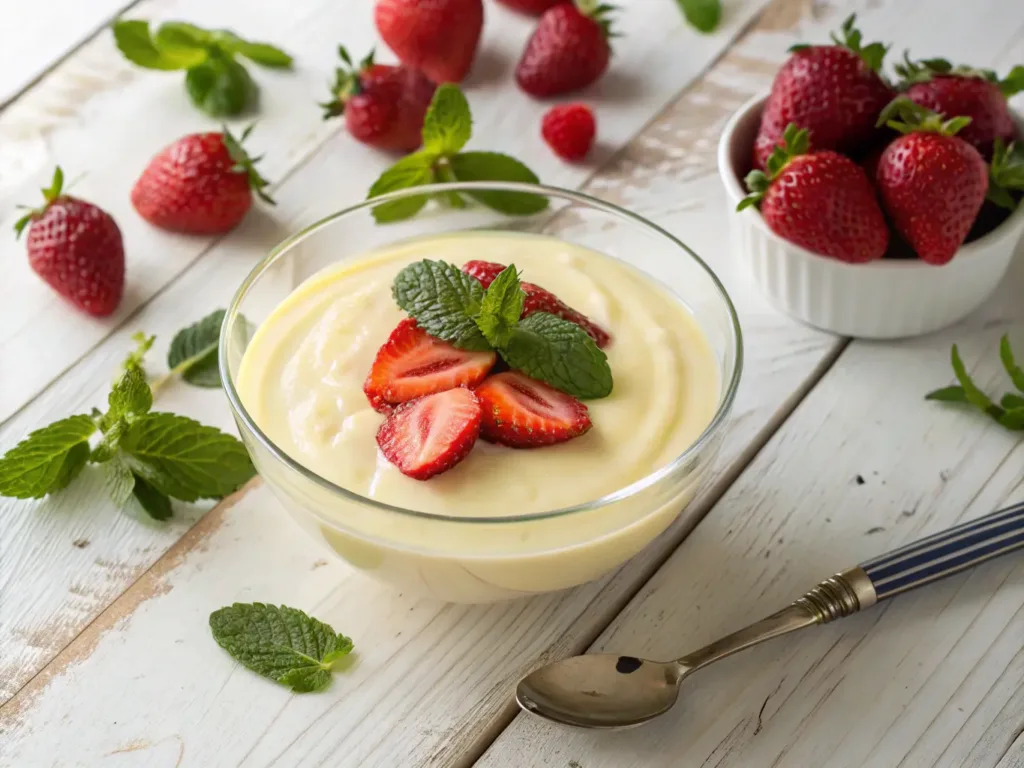Introduction
Looking for a classic dessert that’s smooth, nostalgic, and easier to make than you think? This Vanilla Custard Recipe checks all the boxes. Whether you’re craving a warm spoonful straight from the pot or a chilled dessert with berries, this creamy, egg-based custard delivers pure comfort. In this guide, you’ll discover what sets custard apart from pudding, how to avoid curdling, and why simple ingredients make all the difference. Let’s dive into how to make it flawlessly—plus a few healthy swaps you can try.
The Story & Intro
- What is vanilla custard?
- Why choose a homemade vanilla custard recipe?
Back in my early kitchen days, I thought custard was something you only made from a powder packet. But one rainy Sunday, I decided to try a scratch-made vanilla custard recipe, and I was hooked. It reminded me of those creamy desserts my grandma served with fruit after lunch—smooth, warm, and just sweet enough to satisfy. My first batch curdled (yikes!), but with some research and patience, I cracked the code.
This version uses ingredients you likely have: milk, eggs, vanilla, sugar, butter, and cornstarch. No artificial thickeners. No shortcuts. Just pure, silky goodness.
You’ll gently simmer the milk and vanilla with butter, then slowly whisk in the egg mixture so the proteins set without scrambling. What you’ll end up with is a custard thick enough to coat a spoon but soft enough to pour. Try it with this healthy strawberry compote or over our protein-packed almond banana bites.
Homemade custard doesn’t just taste better—it’s more versatile, too. Use it as a pie filling, a pudding base, or layer it into trifles like we do in this berry vanilla trifle bowl. The base recipe isn’t too sweet, making it perfect for pairing with fresh fruit or granola.
And yes—this is an ideal starter for your dessert lineup on PeakFit. Because delicious doesn’t mean overindulgent.
PrintVanilla Custard Recipe: Silky, Classic, and Healthier Than You Think
This vanilla custard recipe is rich, smooth, and perfectly balanced—not too sweet and ideal for healthy desserts.
- Prep Time: 5 mins
- Cook Time: 10 mins
- Total Time: 15 mins
- Yield: 8
- Category: Dessert
- Method: Stovetop
- Cuisine: American
- Diet: Vegetarian
Ingredients
4 cups whole milk
1 tablespoon vanilla extract
1 teaspoon butter
4 large eggs
½ cup white sugar
3 tablespoons cornstarch
Instructions
1. Place milk, vanilla, and butter in a saucepan and heat to simmer.
2. Whisk eggs, sugar, and cornstarch together.
3. Temper eggs by slowly adding hot milk while whisking.
4. Return mixture to pot and cook over low heat, stirring constantly, until thick.
5. Serve warm or chilled.
Notes
For a sweeter custard, add ¼ cup more sugar. Optional: mix in mashed banana or crushed pineapple.
Pudding, Cream & Custard—What’s the Difference?
- What is the difference between vanilla pudding and vanilla custard?
- Is vanilla cream the same as custard?
A lot of people ask: What’s the difference between vanilla pudding and vanilla custard? It comes down to the thickening agent.
Custard gets its texture from gently heated eggs. That’s what gives it that smooth, creamy, luxurious feel. Pudding, on the other hand, relies on starches like cornstarch for thickness, with eggs often playing a supporting role—or none at all. So if you want that old-fashioned texture and rich mouthfeel, the vanilla custard recipe is your winner.
Vanilla cream is a broad term, often used for pastry cream or chantilly cream, depending on context. Some call crème pâtissière “vanilla cream,” which uses eggs and starch, making it a type of custard. Others refer to sweetened whipped cream as “vanilla cream,” which is entirely different.
Custard walks a middle line. It’s richer than pudding, not as fluffy as mousse, and doesn’t require baking like flan. For healthy eaters, it’s easier to control ingredients and sugar content. Like this protein yogurt mousse or our almond milk chocolate pudding, you can tailor it.
If you love experimenting, the base vanilla custard recipe can evolve. Add espresso powder for a tiramisu layer, lemon zest for brightness, or fold in mashed bananas for a tropical twist. It’s that versatile.
And best of all? You avoid preservatives and excess sweetness found in pre-packaged desserts. That’s a win at PeakFit.
Secrets to a Perfect Custard Texture
- Subheading: What is the secret to good custard?
- Subheading: How to avoid curdling and get silky smooth results?
Making a flawless Vanilla Custard Recipe hinges on controlling heat and timing. The biggest secret? Gentle, consistent heat. Custard thickens when the egg proteins coagulate—but too much heat too quickly causes them to scramble. The fix? Use a heavy-bottom saucepan and keep your burner on low to medium heat.
While stirring, use a silicone whisk or spoon to continuously move the mixture. Stirring prevents the milk from scalding and ensures the eggs incorporate evenly. As soon as the custard coats the back of a spoon (a finger swipe leaves a clean trail), it’s ready to come off the heat.
Another trick for perfect texture is tempering the eggs. This means slowly adding a small amount of warm milk mixture into the beaten eggs before combining everything. It gently brings the eggs up to temperature so they don’t shock and curdle. If you’re following a quick stovetop Vanilla Custard Recipe, you can skip full tempering by whisking thoroughly and heating gradually.
Some recipes add a little cornstarch—like this one—to stabilize the custard and make it more forgiving. The cornstarch also helps maintain the texture once chilled.
Once your custard is done, strain it through a fine mesh sieve to remove any accidental lumps and achieve a flawless finish. Then, cover it with plastic wrap (pressed directly onto the surface) to prevent a skin from forming.
The result? A smooth, luscious Vanilla Custard Recipe that tastes bakery-quality, every time.

Storing, Freezing & Creative Uses
- How to store and reheat vanilla custard
- What to do with leftovers: desserts, toppings & ideas
Storing custard is simple but requires care. Always allow it to cool to room temperature before refrigerating. Place plastic wrap directly over the surface to prevent a skin from forming.
Custard will last in the fridge for 3 days. For reheating, gently warm it on the stove with a splash of milk to loosen it. Avoid the microwave unless you stir constantly and use very short bursts of heat.
Can you freeze this vanilla custard recipe? Technically, yes—for up to 3 months. But freezing alters the texture. It can become watery or grainy after thawing, so if you freeze it, reheat slowly while whisking, then strain.
Leftovers can be magical. Layer it into parfaits, dollop it over fruit salad, or spoon over pancakes. Some of our PeakFit readers love using this base in healthy baked oats or stuffing it between layers of our banana protein cake.
You can even blend leftover custard into smoothies for a dessert-inspired shake. Or freeze it into popsicle molds for a treat kids will love.
However you serve it, this recipe is a timeless, flexible classic that belongs in your healthy dessert toolkit.
1. Why This Vanilla Custard Recipe Works
This vanilla custard recipe works because it blends simplicity with technique. The use of egg yolks and whole milk creates a silky-smooth consistency, while vanilla bean or pure extract infuses the custard with authentic depth. The step-by-step process ensures the custard thickens evenly without curdling, which can often trip up beginners. What sets this vanilla custard recipe apart is the tempering method,
allowing the eggs to gradually adjust to heat without scrambling. You don’t need advanced culinary skills—just a bit of patience and quality ingredients. It’s the go-to base for classic desserts like trifles, tarts, or as a standalone treat chilled in ramekins. When followed correctly, this vanilla custard recipe delivers a luxurious, spoonable texture every time. It’s ideal for make-ahead desserts and perfect for those looking to master a classic.
2. Vanilla Custard vs. Pastry Cream: What’s the Difference?
Many people confuse vanilla custard with pastry cream, but they’re not identical. While both use similar ingredients—milk, sugar, egg yolks, and vanilla—this vanilla custard recipe relies on a thinner consistency meant for pouring or layering, like in a pudding or sauce. Pastry cream, on the other hand, contains flour or cornstarch in larger amounts and is used for filling éclairs, tarts, and cakes.
It’s much thicker and spoonable, not pourable. If you’re after something light, creamy, and versatile, this vanilla custard recipe offers the perfect texture. It can be served warm or chilled, and pairs well with fresh fruit or granola. Meanwhile, pastry cream is strictly for fillings. Knowing the difference helps you choose the right recipe depending on your dessert needs.
3. Top Mistakes to Avoid in a Vanilla Custard Recipe
Even the best vanilla custard recipe can go wrong without care. One common mistake is overheating. Custard is sensitive—too much heat will curdle the eggs and turn your creamy base into scrambled bits. Always cook over low heat and stir constantly. Another pitfall is skipping tempering. Pouring hot milk directly into eggs without tempering shocks them, leading to lumps. This vanilla custard recipe avoids that with step-by-step instructions to temper correctly. Using low-quality vanilla extract can also make or break the final flavor.
Always opt for pure vanilla or real vanilla beans. Lastly, failing to strain your custard can leave behind cooked egg pieces or lumps. Straining through a sieve guarantees a smooth finish. Mastering these common pitfalls is key to executing the perfect vanilla custard recipe.
4. How to Flavor Your Vanilla Custard Recipe
While the base vanilla custard recipe is timeless, you can infuse it with flavors to suit your mood or occasion. Want a spiced twist? Add cinnamon, nutmeg, or cardamom to the milk as it heats. For a citrus version, simmer the milk with strips of lemon or orange peel.
Almond or coconut extracts also make great substitutes or additions to vanilla. To make a mocha custard, stir in a teaspoon of instant espresso and a dash of cocoa powder. Even herbs like lavender or basil can work—just steep them in the warm milk and strain before adding eggs. The great part? This vanilla custard recipe is endlessly adaptable. Just remember: balance is key. Let the vanilla remain the star while complementary flavors enhance the overall profile.
5. Serving Ideas for Vanilla Custard
A good vanilla custard recipe shines in many roles. Pour it warm over apple pie or sticky toffee pudding for a classic finish. Or let it chill in ramekins and top with berries, granola, or a sprinkle of cinnamon. You can also layer it in parfaits with sponge cake, or serve it alongside poached fruit for a light dessert. Try it as the base for a trifle or as a filling in layered no-bake cakes. Want to go upscale? Use your vanilla custard recipe as the foundation for brûlée-style desserts—just sprinkle sugar on top and torch it until caramelized. The silky texture and warm vanilla notes make it the ultimate comfort dessert for any season.

6. Storage and Make-Ahead Tips
One of the advantages of this vanilla custard recipe is how well it stores. Once cooled, cover the surface with plastic wrap to prevent skin from forming and refrigerate for up to 3 days. Always keep it chilled, and never leave it at room temperature for extended periods due to the dairy and egg content. For make-ahead prep, cook the custard the day before serving. If it thickens too much in the fridge, simply whisk in a splash of milk to loosen it before use. Don’t freeze custard—it tends to separate and lose its creamy texture. This vanilla custard recipe is ideal for dinner parties or meal prepping desserts ahead of time.
7. Healthier Swaps for a Guilt-Free Vanilla Custard Recipe
Looking to lighten things up? This vanilla custard recipe can be adapted for a healthier twist. Swap whole milk with unsweetened almond or oat milk for a dairy-free version. Use a natural sweetener like maple syrup or coconut sugar instead of white sugar for a deeper, less processed taste. Want fewer eggs? Use one whole egg and one yolk to cut cholesterol while keeping structure. You can even thicken your custard slightly more with cornstarch to reduce reliance on yolks. These swaps maintain the creamy texture while making the vanilla custard recipe fit for modern dietary preferences. Just keep the balance right—flavor and consistency should remain smooth, not watery.
8. Perfect Pairings for Vanilla Custard
This vanilla custard recipe pairs beautifully with baked goods, fruits, and crunchy toppings. Serve it alongside a slice of banana bread, spice cake, or warm brownies. It also complements fresh berries, roasted pears, or caramelized apples. If you prefer contrast, try chopped nuts like pistachios or almonds sprinkled on top for crunch. Vanilla custard also works well layered with puff pastry in mille-feuille or inside profiteroles. The rich, velvety texture pairs equally well with cold and warm components, making it a versatile dessert component. Whether you’re plating a simple bowl or building an elegant dessert tower, the vanilla custard recipe brings harmony to any dish it joins.

Vanilla Custard Recipe
What is the difference between vanilla pudding and vanilla custard?
Pudding uses starches to thicken while custard uses eggs. Custard is silkier and more traditional.
What is the secret to good custard?
Low heat, slow tempering, and constant whisking are key. Avoid overheating the eggs.
Is vanilla cream the same as custard?
Not exactly. Vanilla cream may refer to whipped cream or pastry cream, which is a thicker type of custard.
What is vanilla custard made of?
Milk, eggs, sugar, vanilla, and a bit of cornstarch or flour. The eggs do the bulk of the thickening.
Short 100-Word Personal Story (Carla’s Touch)
Hey there! I’m Carla, the chef behind PeakFit Recipes. I know what it’s like to want dessert without compromising health. For years, I avoided custards thinking they were too rich—until I made this simple vanilla custard recipe. With whole ingredients and no unnecessary sugar, it brought back memories of family lunches while fitting my lifestyle today. I’m all about making classic recipes lighter and smarter. So, whether you’re living a fit life or just love homemade treats, this custard is proof you can have your (healthy) dessert and love it, too!
FORE MORE RECIPES VISIT US IN FACEBOOK
 Skip to content
Skip to content

